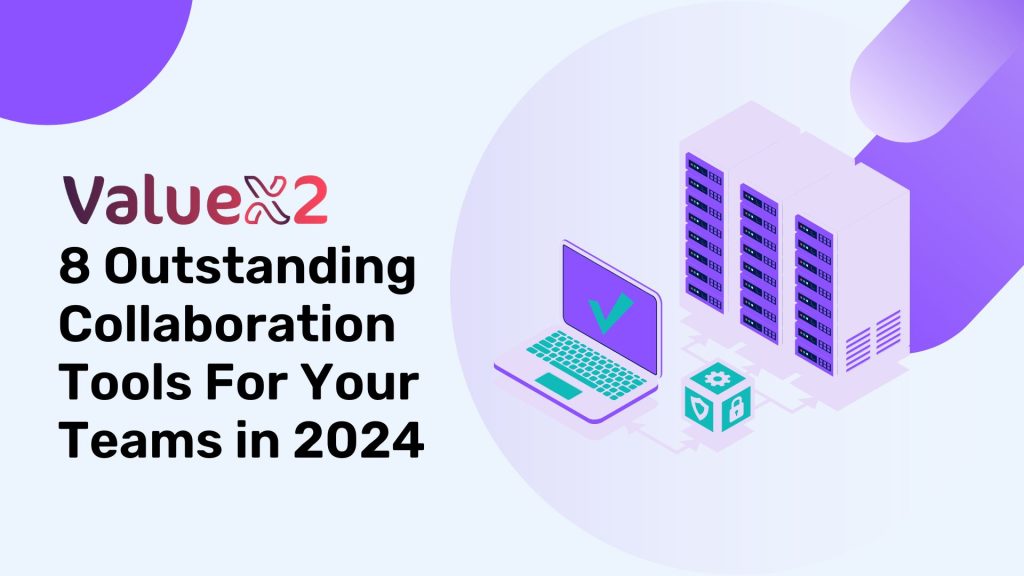Here are the top collaboration tools that will help you work with teams effectively, whether you work from the office or do a remote job.

The key to success in the current business environment is effective collaboration. An organization can have teams working on a job remotely or even across the globe. For such teams to work effectively, you will need help. Where is this help? The appropriate tools may really make a big impact.
We’ll go into the realm of the top collaboration tools for teams in 2024 in this post so you can keep in touch, increase productivity, and preserve flexibility.
Why Collaboration Tools Matter
Collaboration tools are very important, and here are reasons why you need to incorporate them into your organization.
- Enhancing communication guarantees that all team members are in agreement.
- Productivity gains: These can be attained by eliminating bottlenecks and simplifying procedures.
- Improving Flexibility: Allowing for flexible scheduling and remote work.
- Facilitating Agile Methodologies: Encouraging rapid iteration and adaptation.
In 2023, Statista found out that, companies that use collaboration tools witness an increase in productivity by 20% and a corresponding 15% decrease in project timelines.
With that, won’t you want to be among the fold? Here are the best collaboration tools in 2024.
Top Collaboration Tools in 2024
1. Microsoft Teams
Among the leading collaboration tools, Microsoft Teams has secured itself a spot. It offers chat, video conferencing and sharing of files. All these features in one platform, is that not amazing? It is integrated with Office365, which is already the most popular set of tools for organizations. Due to this, businesses that embrace using Microsoft’s ecosystem will find it a great choice.
Features
- Has chat and video conferencing, making it easy to communicate with team members in real time.
- Can share and collaborate on files with ease.
- Integrates with over 700 apps
It offers a free plan but you can upgrade to the paid plan of $5/user/month
2. Slack
Comes with a user-friendly interface and a powerful connection meant to replace emailing as it brings all communication into one aligned piece.
Features
- Channels: Group discussions according to subjects, teams, or projects.
- Direct Messaging: Private or group conversations.
- Integrations: Make connections with more than 2,000 technologies, including Trello and Google Drive.
Free plan is available, the paid plan starts at $6.67/ month.
3. Trello
Trello is a project management tool that uses lists, boards and cards to come up with a decent way to arrange tasks and projects. Does your team use agile methodologies? This is a perfect option for that as it is very flexible.
Features
- Tasks are arranged visually using boards, lists, and cards.
- Power-ups that increase functionality by adding Google Drive, Slack, and other connections.
- Teamwork: Assign responsibilities, establish due dates, and monitor advancement.
Has a free plan and a paid plan of $5 monthly.
4. Asana
Does your team need to organize, track and manage work? Asana has proved to be a reliable tool that can perform absolutely that. Also, it is a comprehensive project management tool that you need to have if you are a team adapting to agile approaches.
Features
- Manage tasks by creating them, distributing them across team members, and establishing deadlines.
- Project timetables: Show the dependencies and timetables for your projects.
- Integrations: Link to over 100 applications, including Slack, Google Drive, and Microsoft Teams.
While there is a free plan available, the premium plan’s monthly cost is $10.99.
5. Miro
Your entire team can be on one platform at once with Miro, no matter where they are at any given time. You may work on projects together, plan, and generate ideas together just like you would if you were in the same area.
Features
- Can come up with interactive whiteboards and distribute them.
- Utilize templates for strategy mapping, ideation, and other purposes.
- Make use of resources like Microsoft Teams, Trello, and Slack.
Free plan with a paid plan starting at $8 per month.
6. Monday.com
Monday.com is a working operating system that is specially designed to get workers the confidence they need to carry out projects and have a smooth workflow.
Features
- Adaptable processes: Modify processes to meet the requirements of your team.
- Use timelines, Kanban boards, and Gantt charts for visual project management.
- Integrations: Connect with more than 40 programs, such as Microsoft Teams, Google Drive, and Slack.
It comes with a free trial and a paid plan that starts at $8 monthly.
7. Zoom
Zoom was put on the map due to its great offerings. It has different capabilities ranging from video conferencing, video meetings, webinars and collaboration.
Features
- Video conferencing: Audio and video calls of the highest calibre.
- Webinars and Events: Organize online seminars and gatherings.
- Integrations: Establish links with programs such as Microsoft Teams, Slack, and others.
Free plan available. Paid plan starts at $14.99 monthly.
8. Google Workspace
Google Workspace is not a new tool, it has been in the game for a while now. You may recognize it by its former name, G Suite. Google Workspace provides several products, including Gmail, Google Drive, Google Docs, and Google Meet. With all this, it makes it powerful for a collaboration platform.
Features
- Email and Chat: Gmail and Google Chat allow for easy communication.
- File Storage and Sharing: Use Google Drive to store and distribute files.
- Work together on documents, spreadsheets, and presentations in real-time with collaborative tools.
Apart from the free trial, it has paid plans beginning at $6 per month.
Choosing the Right Tools for Your Team
Are you caught in a dilemma where you cannot seem to decide which tool best suits your organization? Please consider the following factors:
- Integration with Existing Tools: Make sure the product works with the tools you already use.
- Ease of Use: Select a user-friendly platform to increase adoption.
- Customization & Flexibility: Choose tools that can be adjusted to fit your team’s workflow.
- Collaboration capabilities: Look for solutions that offer comprehensive collaboration capabilities such as real-time editing and communication.
- Security and Compliance: Make sure the tool fulfils your security and compliance standards.
Embracing Agile HR practices
Do you wish to further enhance your team’s efficiency? Is this even possible? The answer is simple, integrating Agile HR practices with your collaboration tools. You know, Agile HR focuses on:
- Adaptive software development which entails using tools that facilitate iterative development and continual improvement.
- Agile Methodology: Using project management frameworks such as Scrum and Kanban for better management.
- Strategic HR Management: For greater results, match HR strategies with overarching company objectives.
For a deeper understanding of Agile HR and its training, ValueX2 has you covered. Here are our resources and courses.
Finale
Investing in the right collaboration tools can help boost your team’s efficiency and the rate of positive production. Together, the best collaboration tools available and Agile methodologies can work. If it can make the most of this, your company will remain connected, flexible, and equipped to meet any obstacles that 2024 may present.
For insight on AI and how it is revolutionization the world, here you go!
Frequently Asked Questions
Q: What are the future collaboration trends?
The future though being unpredictable, holds so much, this includes seamless integration with other tools, AI, and automation to conquer ordinary tasks. They will be more productive with improved user experience.
Q: Which collaboration tool is best?
Some of the best collaboration tools are provided in this article. Please note that they are just but a few. More collaboration tools are:
- Blink: Best known for mobile collaboration
- Troop messenger: If you want to secure messaging, try this.
- Kintone: Best for threaded discussions.
- Forecast: Your go-to for AI project planning.
Q: What is the #1 strategy to improve team collaboration in the workplace?
Important tactics consist of:
- Communicating the company’s mission regularly.
- Expressing the standards for teamwork.
- Showcasing each person’s unique qualities.
- Encouraging a workplace that is a community.
Q: What are the ways to build collaboration?
Building collaboration is an achievable task for any firm. This is how you can improve on teamwork:
- Encourage a welcoming atmosphere.
- Encourage empathy at work.
- Pay attention to comprehending.
- Give direct, useful feedback.

Bhavna is an Agile Coach and Consultant with over a decade of experience in advisory, corporate finance, IT assurance, and operations at Big 4 and within the industry in the UK and India. She has recently been the CEO of a start-up where she implemented agile practices within HR, Marketing, and Product teams.
She is also a SAFe® Practice Consultant (SPC) and authorized instructor for ICAgile Agility in HR (ICP-AHR), Agility in Marketing (ICP-MKG), and Business Agility Foundations (ICP – BAF) training courses. She provides training for agile transformation to corporate, public, and private batches, as well as consulting for enterprise agile transformation.






